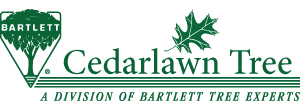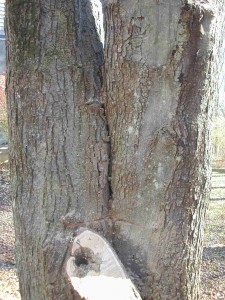Caring for Aging Trees – Part III – Cabling
Safety concerns increase as trees grow larger and mature. That small tree planted to provide some shade for the house will at some point start to take command of its space and may soon tower over your house. Mature trees in smaller properties can also impact neighboring lots and houses. One may readily envision the potential of a large, horizontal limb breaking and causing damage below. Awareness of tree height and proximity to potential hazards should it split or break apart is also important. The actual weight of a falling tree limb will be influenced by factors including: 1) the tree species and its wood density 2) size of the limb 3) presence of decay and 4) moisture content. For example, a healthy 10 foot long and 10” wide red maple branch will probably weigh well over 300 pounds.
There are several common scenarios that will increase susceptibility of a tree to breakage. One is the presence of co-dominant leaders (2 or more upright growing, similarly-sized stems). The interface between these upright-growing stems often contains “included bark” (where the bark of the two stems grows together) and does not form an interconnected bond. This presents a weak point of attachment and can develop into an area that can split apart. The upright-growing stems continue to develop increasing weight loads due to expanding branches and leaf-load. Additional weather-related loading occurs with presence of heavy snow or ice and can be amplified by high winds.
Older trees often have branches that have grown far away from the tree trunk. These are often large diameter, heavy limbs. The presence of wood decay either in the limb itself or where it attaches to the main trunk will increase the probability that the limb may fail at some point. This represents another common scenario where limb breakage can occur.
Cabling can be used to address these weaknesses. Cabling refers to the attachment of a high-strength steel cable between 2 points of attachment (using thimbles and lag eyes, lag hooks or eye bolts depending on limb size) on a tree to reduce movement and load stress within a tree and help stabilize a weak area of the tree. Cables are used 2/3 the distance from the weak attachment to the top of the tree. A direct cable connection is often used although multiple cabling arrangements (triangle, box, etc) can be employed to stabilize a structurally weak attachment. Bracing (insertion of threaded metal rod(s) through a hole drilled through both stems and secured with heavy-duty washers and nuts) can be used along with cabling for co-dominant or split stems to provide additional support. Bracing is used above included bark or through a split.Pruning is often conducted with cabling to reduce weight loads and remove structurally unsound wood. Wood decay may limit cabling options. Cabling hardware should not be used where there is less than 30% sound wood. If structurally sound locations for hardware installation are not available the limb (stem) may need removal. A certified arborist can evaluate the cabling potential and cable a tree to its best advantage.
Cabled trees should be inspected every 7-10 years. Cables and hardware should be checked for breakage or loosening. The location of cable attachment for maximum support can also change over time due to tree growth.






